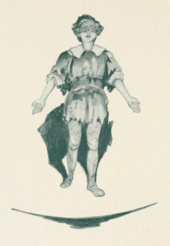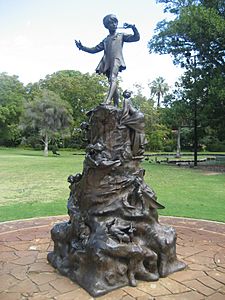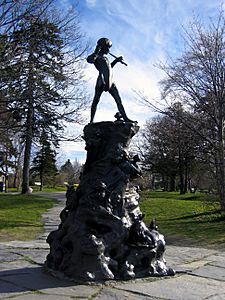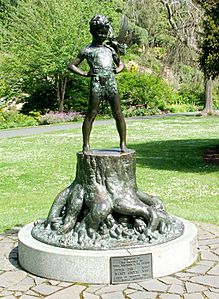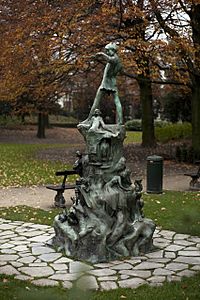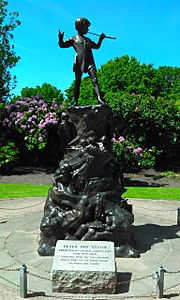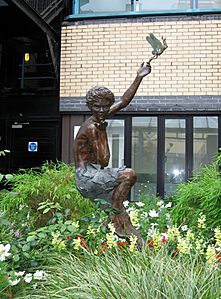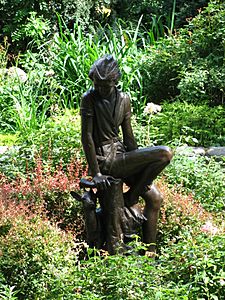Peter Pan facts for kids
Quick facts for kids Peter Pan |
|
|---|---|
| Peter Pan character | |
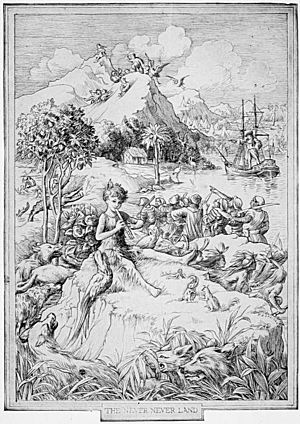
Illustration of Peter Pan playing the pipes, by F. D. Bedford from Peter and Wendy (1911)
|
|
| First appearance | The Little White Bird (1902) |
| Created by | J. M. Barrie |
| Portrayed by | Nina Boucicault (1904 play) Maude Adams (1905 play) Betty Bronson (1924 film) Mary Martin (1954 musical) Robin Williams (Hook) Jeremy Sumpter (2003 film) Robbie Kay (Once Upon a Time) Levi Miller (2015 film) |
| Voiced by | Bobby Driscoll (1953 film) |
| Information | |
| Aliases | The Boy Who Wouldn't Grow Up |
| Species | Human |
| Gender | Male |
| Nationality | English |
Peter Pan is a fictional character created by Scottish novelist and playwright J. M. Barrie (1860–1937). He is a magical boy who can fly and who refuses to grow up. Peter Pan spends his never-ending childhood playing on the small island of Neverland as the leader of his gang, the Lost Boys. He and Tinker Bell, who is a fairy, are always together.
Contents
Origin
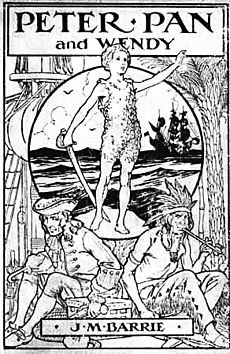
J. M. Barrie first used Peter Pan as a character in a section of The Little White Bird (1902), an adult novel where he appears as a seven-day-old baby in the chapter entitled Peter Pan in Kensington Gardens. Following the success of the 1904 play, Barrie's publishers, Hodder and Stoughton, extracted chapters 13–18 of The Little White Bird and republished them in 1906 under the title Peter Pan in Kensington Gardens, with the addition of illustrations by Arthur Rackham.
He returned to the character of Peter Pan as the centre of his stage play entitled Peter Pan, or The Boy Who Wouldn't Grow Up, which premiered on 27 December 1904 in London. Barrie later adapted and expanded the play's story line as a novel, published in 1911 as Peter and Wendy.
Physical appearance
Barrie never described Peter's appearance in detail, even in his novel, leaving it to the imagination of the reader and the interpretation of anyone adapting the character. In the play, Peter's outfit is made of autumn leaves and cobwebs. His name and playing the flute or pipes suggest the mythological character Pan. Barrie mentions in Peter and Wendy that Peter Pan still had all his "first teeth". He describes him as a beautiful boy with a beautiful smile, "clad in skeleton leaves and the juices that flow from trees".
Traditionally, the character has been played on stage by a petite adult woman. In the original productions in the UK, Peter Pan's costume was a reddish tunic and dark green tights, such as that worn by Nina Boucicault in 1904. This costume is exhibited in Barrie's Birthplace. The similar costume worn by Pauline Chase (who played the role from 1906 to 1913) is displayed in the Museum of London. Early editions of adaptations of the story also depict a red costume but a green costume (whether or not made of leaves) becomes more usual from the 1920s, and more so later after the release of Disney's animated movie.
In the Disney films, Peter wears an outfit that consists of a short-sleeved green tunic and tights apparently made of cloth, and a cap with a red feather in it. He has pointed elf-like ears, brown eyes and his hair is red. In Hook (1991), the character is played as an adult by Robin Williams, with blue eyes and dark brown hair; in flashbacks to him in his youth, his hair is light brown. In this film his ears appear pointed only when he is Peter Pan, not as Peter Banning. His Pan attire resembles the Disney outfit (minus the cap). In the live-action 2003 Peter Pan film, he is portrayed by Jeremy Sumpter, who has blond hair and blue-green eyes. His outfit is made of leaves and vines.
Age
J.M. Barrie created his character based on his older brother, David, who died in an ice-skating accident the day before his 14th birthday. His mother and brother thought of him as forever a boy. The "boy who wouldn't grow up" character has been described as a variety of ages.
- In The Little White Bird (1902) and Peter Pan in Kensington Gardens (1906), he was only seven days old.
- Although his age is not stated in Barrie's play (1904) or novel (1911), the book says that he still had all his baby teeth. In other ways, the character appears to be older, about 12–13 years old.
Personality
Peter is an exaggerated stereotype of a boastful and careless boy. He claims greatness, even when such claims are questionable (such as congratulating himself when Wendy re-attaches his shadow). In the play and book, Peter symbolises the selfishness of childhood, and is portrayed as being forgetful and self-centred.
Peter has a nonchalant, devil-may-care attitude, and is fearlessly cocky when it comes to putting himself in danger. Barrie writes that when Peter thought he was going to die on Marooners' Rock, he felt scared, yet he felt only one shudder. With this blithe attitude, he says, "To die will be an awfully big adventure". In the play, the unseen and unnamed narrator ponders what might have been if Peter had stayed with Wendy, so that his cry might have become, "To live would be an awfully big adventure!", "but he can never quite get the hang of it".
Abilities
Peter's archetypal quality is his unending youth. In Peter and Wendy, it is explained that Peter must forget his own adventures and what he learns about the world in order to stay childlike.
Peter's ability to fly is explained, but inconsistently. In The Little White Bird, he is able to fly because he is said to be part bird, like all babies. In the play and novel, he teaches the Darling children to fly using a combination of "lovely wonderful thoughts" and fairy dust. In Barrie's Dedication to the play Peter Pan, The Boy Who Wouldn't Grow up, the author attributes the idea of fairy dust being necessary for flight to practical needs:
...after the first production I had to add something to the play at the request of parents (who thus showed that they thought me the responsible person) about no one being able to fly until the fairy dust had been blown on him; so many children having gone home and tried it from their beds and needed surgical attention. - J.M. Barrie
Peter has an effect on the whole of Neverland and its inhabitants when he is there. Barrie states that although Neverland appears different to every child, the island "wakes up" when Peter returns from his trip to London. In the chapter "The Mermaids' Lagoon" in the book Peter and Wendy, Barrie writes that there is almost nothing that Peter cannot do. He is a skilled swordsman, rivalling even Captain Hook, whose hand he cut off in a duel. He has remarkably keen vision and hearing. He is skilled in mimicry, copying the voice of Hook and the ticking of the clock in the crocodile.
Peter has the ability to imagine things into existence and he is able to feel danger when it is near.
In Peter and Wendy, Barrie states that the Peter Pan legend Mrs Darling heard as a child was that when children died, he accompanied them part of the way to their destination so they would not be frightened. This is a role similar to the Greek god Hermes as a psychopomp.
In the original play, Peter states that no one must ever touch him (though he does not know why). The stage directions specify that no one does so throughout the play. Wendy approaches Peter to give him a "kiss" (thimble), but is prevented by Tinker Bell. However, John Caird and Trevor Nunn's introduction to the script for the 1997 Royal National Theatre production, states that this was never Barrie's original intention, and was only added for a production in 1927, where Jean Forbes-Robertson took the title role, and played the part with a lighter, more fairy-like, physicality. Robertson was to play the part almost every year until 1939.
Cultural allusions
The character's name comes from two sources: Peter Llewelyn Davies, one of the five Llewelyn Davies boys who inspired the story, and Pan, a minor deity of Greek mythology who plays pipes to nymphs and is part human and part goat. This is referenced in Barrie's works (particularly Peter Pan in Kensington Gardens) where Peter Pan plays pipes to the fairies and rides a goat. The god Pan represents Nature or Man's natural state in contrast to Civilisation and the effects of upbringing on human behaviour. Peter Pan is a free spirit, being too young to be burdened with the effects of education or to have an adult appreciation of moral responsibility. As a 'betwixt-and-between', who can fly and speak the language of fairies and birds, Peter is part animal and part human. According to psychologist Rosalind Ridley, by comparing Peter's behaviour to adults and to other animals, Barrie raises many post-Darwinian questions about the origins of human nature and behaviour. As 'the boy who wouldn't grow up', Peter exhibits many aspects of the stages of cognitive development seen in children and can be regarded as Barrie's memory of himself as a child, being both charmingly childlike and childishly solipsistic.
Relationships
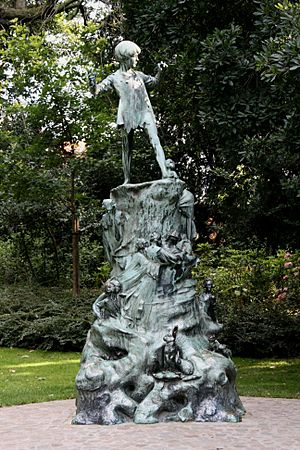
Family
Peter Pan ran away from his parents when he was a baby as told in Peter Pan in Kensington Gardens and Peter and Wendy. Finding the window closed and seeing a new baby in the house when he returned some time later, he believed his parents no longer wanted him and never came back. This younger sibling is referred to in the chapter "Lock-Out Time" in Peter Pan in Kensington Gardens but is not mentioned again.
Friends
Maimie Mannering
While in Kensington Gardens, Peter meets a lost girl named Maimie Mannering and the two quickly become friends. Peter proposes marriage to Maimie. While Maimie wants to stay in the Gardens with Peter, she comes to realise that her mother is so worried that she must return to her. Maimie promises to always remember Peter and goes back to her mother. When Maimie grows up, she continues to think of Peter, dedicating presents and letters to him. To remember Maimie, Peter rides the imaginary goat that Maimie created for him. She is considered to be the literary predecessor of Wendy Darling.
The Darlings
Wendy Darling
Wendy is hinted to have romantic feelings for Peter, but cannot be with him because of his inability to love back. In the 2003 film Peter Pan, the feeling is mutual. Captain Hook can only take away Peter's ability to fly by thoughts of Wendy leaving him, growing up, and replacing him with a husband. Wendy saves Peter by giving him her hidden kiss (signifying he is her true love); this gives him the will to live. In the movie Hook, an older Wendy implies that she used to (and perhaps, still does) have feelings for Peter, saying that she was shocked that he did not prevent her wedding day. In the sequel to the 1953 Disney film, Return to Neverland, Peter and a grown-up Wendy are briefly, but happily, reunited after many years and continue to show feelings for each other.
In the original novel, Peter later befriends Wendy's daughter Jane (and her subsequent daughter Margaret), and it is implied that this pattern will go on forever. From time to time Peter visits the real world, and befriends children. Wendy Darling, whom he recruited to be his "mother", is the most significant of them; he also brings her brothers John and Michael to Neverland at her request. It is mentioned that Wendy was the only girl who captured his attention.
John Darling and Michael Darling
John, the older brother of the Darlings, proves to be extremely mature for his age. He becomes fascinated with piracy and imitates Captain Hook while playing at home with his siblings. Not only sophisticated, John is also courageous and smart. Peter typically tasks John with the responsibility of directing the Lost Boys when Peter is absent. Michael, the youngest of the Darlings, is convinced that Peter Pan is a real person after hearing Wendy's passionate narratives about him. During nursery games, it's Michael who plays the role of Peter Pan whom he looks up to.
Mary and George Darling
The parents of Wendy, John and Michael. Mr Darling works as a clerk in the City, and is named after George Llewelyn Davies. Mrs Darling is named after Mary Ansell, Barrie's wife.
Neverland inhabitants
Tiger Lily
Tiger Lily is the daughter of Great Big Little Panther, the chief of the Piccaninny Native American tribe resident in Neverland. Barrie refers to her as "a princess in her own right", and she is often described as such. She is kidnapped by the pirates and left to die on Marooners' Rock, but is rescued by Peter. It is hinted later that she may have romantic feelings for Peter but he does not return them, as he is completely oblivious of other people's feelings. In the Disney film, Tiger Lily shows her gratitude by performing a dance for Peter and kissing him. The kiss makes him turn bright red, and makes Wendy jealous of Tiger Lily.
Tinker Bell
Tinker Bell is a common fairy who is Peter Pan's best friend and often jealously protective of him. She is the friend who helps him in his escapades. As his fairy, Tink’s malicious actions are usually caused by her jealousy which leads to the Lost Boys shooting arrows at Wendy, and eventually even reveals Peter’s hideout to Captain Hook, thinking that Wendy will be captured rather than Peter. When Tink realises her serious mistake, she risks her own life by drinking the poison Hook has left for Peter (or pushing Hook’s bomb away in Disney's movie). Her extreme loyalty and dedication to Peter is everlasting.
The Lost Boys
Peter is the leader of the Lost Boys, which include Tootles, Nibs, Slightly, Curly, and The Twins. The Lost Boys is a band of boys who were lost by their parents after they "fall out of their perambulators" and came to live in Neverland. In Barrie's novel Peter and Wendy (but not the original play Peter Pan), it is stated that Peter "thins them out" when they start to grow up. This is never fully explained, but it is implied that he either kills them or banishes them.
In the song "I Won't Grow Up" from the 1954 musical, the boys sing "I will stay a boy forever" to which Peter replies "and be banished if I don't".
In Peter Pan in Scarlet (2006), the official sequel to Barrie's Peter and Wendy, what happens to the Lost Boys when they begin to grow up is revealed when Slightly starts to grow older, as Peter banishes him to Nowhereland (which basically means that he and all his allies will ignore the banished person's existence), the home of all the Long Lost Boys whom Peter has banished in times past.
The Crocodile
The crocodile (Tick-Tock in the Disney film) is Captain Hook's nemesis. After Peter Pan cut off Captain Hook's hand in a fight and threw it into the sea, the crocodile swallowed it and got a taste for Hook. It also swallowed a ticking clock, which alerts Hook of its presence.
Adversaries
Captain Hook
Captain Hook, whose right hand was cut off in a duel, is Peter Pan's arch-enemy. Hook's crew, including Smee and Starkey, also consider him a foe. Captain Hook's two principal fears are the sight of his own blood (which is supposedly an unnatural colour) and one crocodile. His name plays on the iron hook that replaced his hand cut off by Peter Pan and eaten by a saltwater crocodile, which continues to pursue Hook.
In the 1953 animated film, Hook seeks revenge on Peter Pan for having fed the crocodile his hand, and refuses to leave Neverland without satisfaction. Hook is supported by Mr. Smee. After promising Tinker Bell 'not to lay a finger (or a hook) on Peter Pan', he lays a bomb in Peter's hideout. At the conclusion of the film, Hook is chased by the crocodile into the distance. Walt Disney insisted on keeping Hook alive, as he said: "The audience will get to liking Hook, and they don't want to see him killed." In the sequel Return to Never Land, Hook mistakes Wendy's daughter Jane for Wendy, and uses her as bait to lure Peter Pan to his death.
Mr. Smee
Mr. Smee is Captain Hook's boatswain ("bo'sun") and right-hand man in J. M. Barrie's play Peter Pan and the novel Peter and Wendy. Mr. Smee is Captain Hook’s direct confidant. Unlike the other pirates, Smee is often clumsy and incapable of capturing any of the Lost Boys. Rather than engaging in Hook’s evil schemes, Smee finds excitement in bagging loot and treasures.
Public sculptures
Barrie commissioned a statue of Peter Pan by sculptor George Frampton which was erected overnight in Kensington Gardens on 30 April 1912 as a May Day surprise to the children of London. Seven statues have been cast from the original mould. The other six are located in:
- Egmont Park, Brussels, Belgium, 1924
- Bowring Park, St. John's, Newfoundland, Canada, Bowring Park, 1925
- Johnson Park, Camden, New Jersey, United States, 1926
- Queens Gardens, Perth, Western Australia, 1927
- Sefton Park, Liverpool, England, 1928
- Glenn Gould Park, Toronto, Ontario, Canada, 1929
Other statues are:
- The town council of Melbourne, Australia, commissioned a statue of Peter Pan in 1926; it is now located in Melbourne Zoo.
- A bronze statue by Charles Andrew Hafner was originally created in 1928 for a fountain in the lobby of the old Paramount Theater in Times Square but is now situated in Carl Schurz Park, New York.
- A statue of Pan by Alex Proudfoot RSA, Principal of Glasgow School of Art, was erected at the Mearnskirk Hospital for children in Glasgow in 1949, commissioned by Alfred Ellsworth in memory of his friend Dr John A Wilson, first superintendent of Mearnskirk Hospital. Wilson had also been a school friend of J.M. Barrie.
- A statue by Ivan Mitford-Barberton was commissioned by Vyvyan and Gwen Watson in remembrance of their son Peter and given in 1959 to the Red Cross War Memorial Children’s Hospital in Western Cape, South Africa.
- A pair of statues by Cecil Thomas, one showing Peter Pan and Tinker Bell, and the other Wendy and the Darling children, are located in Dunedin Botanic Gardens in Dunedin, New Zealand since the 1960s.
- Two bronze casts of a statue by Alistair Smart, originally commissioned by the Angus Milling Company in 1972, are in Kirriemuir, Scotland, one in the main town square and the other in the Peter Pan Garden by Barrie's Birthplace, now owned by the National Trust of Scotland.
- A bronze statue in front of the Weatherford, Texas public library honouring Weatherford native Mary Martin, sculpted by Ronald Thomason in 1976. Martin had portrayed Peter Pan in the 1954 Broadway Musical production and several subsequent telecasts.
- A bronze statue by Diarmuid Byron O'Connor was commissioned by Great Ormond Street Hospital in London and unveiled in 2000, showing Peter blowing fairy dust, with Tinker Bell added in 2005.
- Statues of Peter Pan
-
Statue in Kirriemuir, Scotland
-
Statue in Perth, Australia
-
Statue in St. John's, Canada
-
Statue in Dunedin, New Zealand
-
Statue in Egmont Park, Brussels, Belgium
-
Peter Pan statue, Sefton Park, Liverpool
See also
 In Spanish: Peter Pan para niños
In Spanish: Peter Pan para niños


